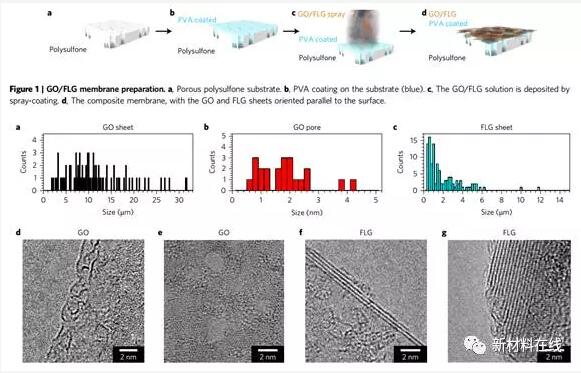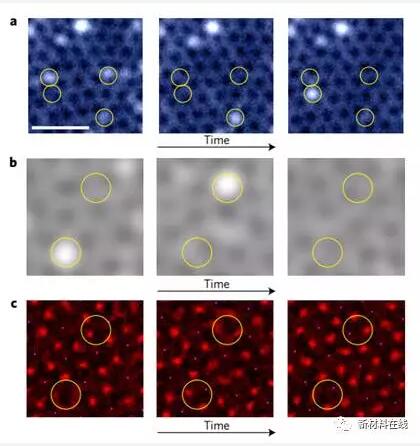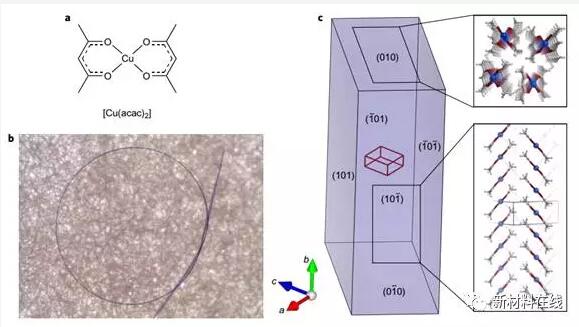Abstract 1. Electrochemical actuators based on metal molybdenum disulfide nanosheets The actuators that convert electrical energy into mechanical energy are useful in a variety of electromechanical systems and robotics, including application to steerable catheters, aircraft adaptation. Wings and drag reduction wind turbines, etc. The actuator system can be based on...
1. Electrochemical actuator based on metal molybdenum disulfide nanosheets 
Actuators that convert electrical energy into mechanical energy are useful in a variety of electromechanical systems and robotics, including applications for steerable catheters, aircraft adaptive wings, and drag reducing wind turbines. The actuator system can be based on various stimuli such as heat, solvent adsorption/desorption or electrochemical action (in systems such as carbon nanotube electrodes, graphite electrodes, polymer electrodes, and metals). Acerce et al. demonstrated that the dynamic expansion and contraction of the formed electrode film can produce significant mechanical forces by re-depositing the nanosheets obtained by chemical stripping of two-dimensional metal molybdenum disulfide (MoS2) on a thin plastic substrate. Specifically, the MoS2 film is capable of producing mechanical stresses of approximately 17 MPa, which is higher than mammalian muscle (approximately 0.3 MPa) and comparable to ceramic piezoelectric actuators (approximately 40 MPa), and up to 1 Hz In the case, the strain is about 0.6%. The actuator performance is attributed to the high conductivity of the 1S phase of the MoS2 nanosheet metal, the elastic modulus of the heavily deposited MoS2 layer (2 to 4 gigapascals), and the rapid proton diffusion between the nanosheets. These results may lead to the creation of new electrochemical actuators for high strain and high frequency applications. (Nature DOI: 10.1038/nature23668)
2. Dynamic multinuclear sites formed by free copper ions in NOx selective catalytic reduction 
Copper ion exchange into zeolite is active for selective catalytic reduction (SCR) with ammonia (NH3) and nitrogen oxides (NOx), but the dependence of low temperature reaction rate on copper (Cu) bulk density is associated with a single site. The reaction is inconsistent Paolucci et al. combine steady-state and transient kinetic measurements, X-ray absorption spectroscopy, and first-principles calculations to demonstrate that under reaction conditions, free Cu ions can cross the zeolite window and form participatory oxygen (O2)-mediated The CuI→CuII redox overall step into the transient ion pair of the SCR. The electrostatic binding of the center of the skeleton limits the volume that each ion can explore, limiting its ability to form ion pairs. The dynamic reversible formation of a single atom by a single atom exhibits a unique phenomenon beyond the conventional boundaries of heterogeneous or homogeneous catalysts. (Science DOI: 10.1126/science.aan5630)
3. Highly exclusive rejection of NaCl and dye by mixed graphene oxide/graphene layered film 
Carbon nanomaterials are very robust and have a unique appeal to separation technology applications, but their scalability and high salt tolerance remain challenging when subjected to long periods of intense cross flow. Morelos-Gomez et al. proposed a graphene-based film by spraying a graphene oxide/several layer of graphene/deoxycholate aqueous dispersion using a simple and environmentally friendly method. The film is very strong enough to withstand long-term (120 hours) strong lateral flow shear while maintaining a rejection rate of 85% and 96% for the anionic dye NaCl. Experimental results and molecular dynamics simulations show that the presence of deoxycholate enhances the rejection of NaCl by these graphene-based membranes. In addition, these novel mixed layered films exhibit better chlorine resistance than pure graphene oxide films. The desalination performance and shear and chlorine resistance of these expandable graphene-based membranes are expected to be used in practical water separation applications. (Nature Nanotechnology DOI: 10.1038/NNANO.2017.160)
4. Effect of vertex oxygen on the degree of plane exchange interaction in copper superconductors 
In high Tc superconductors, the magnetic and electronic properties are determined by the probability that the valence electrons in the CuO2 plane effectively transition from one point to another, which is in contrast to on-site Coulomb repulsion and is supported by jump integration. The spatial extent of the latter is related to the transmission properties (including superconductivity) and the dispersion relation of spin excitons (magnetons). Peng et al. measured and compared three antiferromagnetic precursor compounds with different atomic numbers at the top of the reciprocal X-ray scattering over a large part of the reciprocal space (single layer Bi2Sr0.9La1.1CuO6+δ, Magnetic spectra of double-layered Nd1.2Ba1.8Cu3O6 and infinite layer CaCuO2). They observed that the lack of vertex oxygen increases the extent of the jump in the plane, while in CaCuO2, the vertex oxygen contributes to a true three-dimensional (3D) exchange bond network. These results establish a correspondence between exchange interactions and crystal structures and provide new insights into the material dependence of superconducting transition temperatures. (Nature Physics DOI: 10.1038/NPHYS4248)
5. Cool the molecules below the Doppler limit Magneto-optical capture and sub-Doppler cooling are essential for most quantum degenerate gases, optical crystal lattices, atomic fountains, and many other applications. A wide range of new applications are looking forward to ultra-cold molecules, and laser cooling has begun to extend to molecules. The magneto-optical trap (MOT) has been demonstrated in the single-molecule substance SrF, but has not yet reached the sub-Doppler temperature required for many applications. Truppe et al. demonstrated the MOT of the second substance, CaF, and showed how to use 3D optical glue to cool these molecules to 50 μK well below the Doppler limit. These ultra-cold molecules can be loaded into optical tweezers to capture any array for quantum simulation, or put into molecular fountains for testing basic physics, or to study collisions between atoms and molecules at ultra-cold temperatures. And chemistry. (Nature Physics DOI: 10.1038/NPHYS4241)
The spontaneous formation and kinetics of semi-sigmite in chiral liquid crystal films 
The sigmoid is a non-core vortex excitation that occurs in different concentrated material systems, and its real-time observation of its dynamics has been a challenge. For the first time, Nych et al. directly observed the spontaneous formation of semi-sigmite. In the film of the chiral liquid crystal, depending on the experimental conditions including the film thickness, they form a hexagonal lattice having a lattice constant of several hundred nanometers, or appear as an isolated entity that compensates for the topological defects of the charge. These semi-Sigmunds exhibit wonderful dynamic properties driven by thermal fluctuations. Although the feature scale is close to the optical resolution limit, the numerical calculation of the final real space imaging successfully confirmed the experimental observation. The chiral liquid crystal film thus provides a wonderful platform for direct exploration of topological excitation kinetics, such as semi-sigmite and its operation using optical techniques. (Nature Physics DOI: 10.1038/NPHYS4245)
7. Atomic analysis of the change of the elastic crystal structure of copper (II) acetylacetonate 
Single crystals are usually fragile and non-elastic materials. This mechanical response limits their use in practical applications, particularly in flexible electronics and optics. Worthy et al. describe a well-known coordination compound, a single crystal of copper (II) acetylacetonate, which has sufficient flexibility to reversibly bind to a knot. Mechanical measurements have shown that such crystals exhibit the elasticity of a soft material similar to nylon and thus exhibit properties that are both related to both hard and soft materials. Using microfocus synchrotron radiation, Worthy et al. mapped the crystal structure changes that occurred during bending, thus determining the mechanism that allows for atomic precision flexibility. Under strain, the molecules in the crystal can reversibly rotate to reorganize to allow for the mechanical compression and expansion required for elasticity, while still maintaining the integrity of the crystal structure. (Nature Chemistry DOI: 10.1038/NCHEM.2848)
8. Polyoxometalate-framework materials designed and synthesized from cluster precursors 
Inorganic oxide materials are commonly used in semiconductor electronics, ion exchange, catalysis, coatings, gas sensors, and as separate materials. Although the synthesis of these inorganic oxide materials is well understood, the range of new materials has been reduced due to the stability limitations imposed by high temperature processing and top down synthesis methods. In this review, Vilà -Nadal et al. describe the derivatization of polyoxometalate (POM) clusters, which allows them to be assembled into a series of frameworks using organic or inorganic connectors. In addition, bottom-up synthetic methods can be used to prepare metal oxide framework materials, and features of POM molecular precursors can remain in these structures. The highly robust all-inorganic framework can be prepared using metal ion linkages, allowing molecular synthesis control without the need for organic components. The obtained skeleton has high stability, high catalytic, photochemical and electrochemical activity. Conceptually, these inorganic oxide materials bridge the gap between the zeolite and the metal-organic framework (MOF) and establish a new class of all-inorganic POM frameworks that can be modeled using MOF-like topologies and reaction principles. design. (Nature Reviews Materials DOI: 10.1038/natrevmats.2017.54)
Minimalist Wall Lamp
A minimalist style Wall Lamp is characterized by its simplicity and clean lines. It typically features a sleek and streamlined design, with minimal ornamentation or decorative elements. The focus is on functionality and minimalism, with a emphasis on using only essential materials and shapes.
Some common features of a minimalist style wall lamp include:
1. Simple geometric shapes: The lamp may have a basic shape, such as a rectangle or a cylinder, without any intricate details or embellishments.
2. Neutral colors: Minimalist wall lamps often come in neutral colors like white, black, or metallic finishes. These colors help to create a clean and uncluttered look.
3. Thin profile: The lamp may have a slim and slender profile, with a thin arm or base that extends from the wall. This helps to maintain a minimalist aesthetic and prevent the lamp from overpowering the space.
4. Integrated or hidden wiring: Minimalist wall lamps often have integrated or hidden wiring, which adds to the clean and seamless appearance. This means that the lamp is designed in a way that the wiring is not visible or distracting.
5. LED lighting: LED lights are commonly used in minimalist wall lamps due to their energy efficiency and sleek design. LED lights can be incorporated into the lamp in various ways, such as embedded strips or discreet bulbs.
Overall, a minimalist style wall lamp is a functional and stylish lighting option that complements modern and contemporary interiors. Its simplicity and clean lines make it a versatile choice for various spaces, from living rooms to bedrooms and even offices.
Minimalist Wall Lamp,Minimalist Wall Light,Minimalist Wall Lights,Minimalist Wall Lamps
Zhongshan Seekyo Lighting CO., Ltd. , https://www.seekyomodernlamp.com







